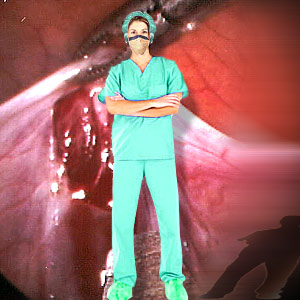Uterine Fibroid Embolization

Uterine fibroid embolization (UFE) is a minimally invasive interventional radiology procedure for uterine fibroids. Most women with symptomatic fibroids can undergo UFE after due consultation with an interventional radiologist. Fibroid tumors are a common occurrence among 20 to 40% of women over age 35. Uterine fibroids are benign and noncancerous growth in the walls of the uterus. These could be small or large in size and most women do not know they have fibroids as they do not cause any symptoms. Some experience heavy menstrual bleeding and periods last longer than usual.
What does uterine fibroid embolization (UFE) mean?
The term embolization means to stop or block the flow of blood. In UFE, blood supply to the fibroid is blocked. Fibroid tumors grow due to the large blood supply that keeps them growing. Fibroids will shrink if the blood supply to them is stopped completely.
Symptoms of fibroids
- Pain and/or a feeling of pressure in the pelvic area, back or legs
- Pain during sexual intercourse
- Constant feeling to urinate
- A feeling of penetration in the bowels
- Constipation
- Bloating
Preparation for the UFE procedure
An MRI, or an ultrasound is performed prior to the UFE procedure to determine if fibroid tumors are the cause for the symptoms and to fully assess the size, number and location of the fibroids. Some gynecologists prefer to perform a laparoscopy, which enables a direct look at the uterus. A biopsy of endometrium is performed to rule out cancer.
Any allergies to the local anesthetic medications should be informed to the doctor. Physicians normally advise stopping supplements, local anesthetic medications and anti inflammatory drugs or blood thinners. It is advised not to eat or drink anything after midnight before the procedure.
UFE procedure
- UFE is not a surgery although it is performed in the hospital. Patients are given medication before the procedure to help them relax. UFE procedure does not cause any pain.
- UFE is a minimally invasive procedure and it is image guided. UFE is performed by a specially trained interventional radiologist.
- The procedure is typically performed in a cath lab. The patient is connected to monitors that track heart rate, blood pressure and pulse during the procedure. An intravenous line is connected into the vein or arm so that sedative medication can be given intravenously.
- The procedure begins with a tiny incision in the groin area. A thin and a flexible tube called catheter is passed through the incision through an artery in the uterus using x ray guidance. The area where the catheter is inserted in the body is shaved, sterilized and covered with a surgical tape. The doctor then injects tiny particles of plastic and gelatin sponge in the catheter, about the size of a grain of sand. While the particles move through the catheter, they stop the flow of blood to the fibroid and cause the fibroid to shrink or disappear completely over time.
- At the end of the procedure, the catheter is removed and pressure is applied to stop any bleeding. The opening in the skin is covered by dressing and no sutures are necessary. It takes about 90 minutes to complete the procedure.
- In the UFE procedure, radiologists use a fluoroscope to guide the small particles to the uterus and fibroids.
- UFE success rate is almost 85 to 90%. Most women stay in the hospital overnight following the procedure.
The patient has to remain in the hospital overnight to receive pain medications and remain under observation. They can return to normal activities in a week's time. UFE procedures are used to stop pelvic bleeding caused by trauma, gynecological tumors that are malignant, hemorrhage after childbirth.
Side effects of UFE
As is with any other procedure, there is a certain risk involved with UFE. Most women can expect moderate to severe cramps for the first few hours following the procedure. Some women may experience nausea and fever. Sometimes an infection may occur and antibiotics are prescribed. Although rare, injury to the uterus occurs in about 1% of procedures and can make hysterectomy necessary. In some women, immediate menopause following the procedure is reported.
Benefits and risks of UFE
The advantages or benefits of UFE include:
- UFE is a lesser invasive procedure than open surgery to remove uterine fibroids.
- No surgical incision is needed in UFE procedure except a small nick in the skin that does not have to be stitched close.
- Normal activities can be resumed in a weeks' time or even earlier.
- Blood loss during UFE procedure is minimal. Recovery time is also shorter.
- General anesthesia is not required in UFE procedure.
- In about 90% of women who have undergone UFE, there is complete resolution of fibroid-related symptoms. On an average fibroids shrink to half their original volume which amounts to about a 20% reduction in their diameter.
- It is rare for treated fibroids to re-grow or for new ones to develop after UFE.
Risks of UFE procedure
- It can be said that any procedure that involves placement of catheter inside blood vessel is risky. The risks include damage to blood vessel, bruising or bleeding at the puncture site, and infection.
- Any procedure when skin in penetrated causes infection. The chance of infection during antibiotic treatment appears to be less than one in 1,000.
-
The normal tissue gets deprived of oxygen supply if the embolic agent is lodged in the wrong place.
- There could be occasional allergic reaction to the x-ray contrast material used during UFE. These could range from mild itching to severe reactions that can affect a woman's breathing and blood pressure.
- In about 2 - 3% of women, small pieces of fibroid tissue will pass after UFE. Women with this problem may require D and C to be certain that all the material is removed so that bleeding and infection does not develop.
- Normal menstrual cycle resumes in a majority of women undergoing UFE. However, in approximately 1-5% of women, menopause occurs after UFE. This is more common with women above 45 years of age.
- In some women if the infection persists, there is likelihood of hysterectomy.
Those who wish to have children should consider surgical removal of individual tumors as the effects of uterine fibroid embolization on pregnancy are not yet conclusive. Since it is not possible to predict whether the uterine wall is weakened by UFE, it is recommended to undergo a Cesarean section rather than risk rupturing the wall of the uterus.
Limitations of UFE
Uterine fibroid embolization should not be performed in women who exhibit no symptoms from the fibroid tumors, or when there is a possibility of cancer or when there is inflammation or infection in the pelvis. Women who desire to have a baby sometime in the future should not be recommended UFE. There are cases of ovarian failure after UFE and these need hysterectomy to treat infection after UFE.
It is imperative to have UFE done with a trained interventional radiologist who has enough experience in this procedure. Any woman who may be allergic to contrast material should also not be offered UFE line of treatment.
UFE is a good treatment option for those women who do not wish to receive blood transfusion or who have other health problems that make general anesthesia dangerous. UFE has several advantages over hysterectomy, mynomectomy and other treatments like GnRH, where hormone suppressor medicine is used to shrink fibroids. Most insurance company does pay for this UFE procedure and it is advised to check with the insurance company to see if the policy is about this procedure.
Top of the Page: Uterine Fibroid Embolization
Tags:#Uterine Fibroid Embolization #UFE #Uterine Fibroid Embolization procedure #Uterine Fibroid Embolization recovery #Uterine Fibroid Embolization side effects #Uterine Fibroid Embolization risks #Uterine Fibroid Embolization complications #Uterine Fibroid Embolization recovery

Inserting Tampon
Pre Menstrual Syndrome Symptom
Painful Menstrual Cramps
Prolonged Menstruation
Menstrual Regulation
Menstruation after Birth
Menstrual Cup
Menstruation and Breastfeeding
Dysfunctional Uterine Bleeding
Breakthrough Bleeding
Uterine Fibroid Embolization
Vaginal Bleeding After Menopause
Menopause Symptom
Hormone Replacement Therapy
Black Cohosh
Pelvic Inflammatory Disease
Top of the Page: Uterine Fibroid Embolization
Popularity Index: 100,977

